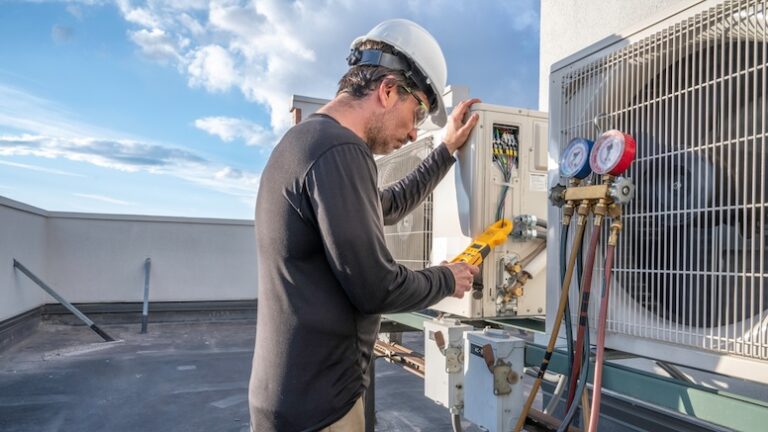— 4 min read
Inside Ductless HVAC Systems


Last Updated Jun 25, 2025

Michael Spano
Solutions Engineer, Public Sector
Michael Spano is a Procore Solutions Engineer who partners with Public Sector agencies to deliver tailored technical solutions for their project management and construction processes. Michael brings a strong background in the construction and engineering industries, having spent time focusing on HVAC, plumbing design and managing a wide range of construction projects.

Diane McCormick
Writer
49 articles
Diane McCormick is a freelance journalist covering construction, packaging, manufacturing, natural gas distribution, and waste oil recycling. A proud resident of Harrisburg, PA, Diane is well-versed in several types of digital and print media. Recognized as one of the premier voices in her region, she was recognized as the Keystone Media Freelance Journalist of the Year in 2022 and again in 2023.
Last Updated Jun 25, 2025

As construction projects grow in size and complexity, ductless HVAC systems are gaining traction. In a world demanding customizable solutions and sustainability, ductless HVAC is flexible and energy efficient.
HVAC contractors who expand their ductless-system capabilities position themselves to win more and bigger projects, but achieving proficiency adds new factors to consider, including costs, installation, risk mitigation, and operational efficiencies.
This article explores the pros and cons of ductless systems, what makes installation different and how HVAC contractors can become trusted advisers and providers as more projects go ductless.
Table of contents
Considering Ductless: Important Factors
Ductless systems, also known as mini-splits, dispense conditioned air by circulating refrigerants from exterior condensers directly to air handler units installed inside the space being targeted for heating or cooling.
While project owners and designers have the ultimate say in whether to go ductless or ducted, HVAC contractors can share their expertise, providing guidance regarding major decision points.
Greenbuild vs. Renovation Savings
With new construction, key decision drivers include costs, the heating and cooling needs of individual spaces, and operational efficiencies. In many cases, ductless systems take the lead in all three areas.
Buildings slated for renovations often have ductwork that can remain serviceable, especially with a relatively simple upgrade to a more efficient air handler.
While removing ducts from existing structures can be costly, simply abandoning ductwork in favor of ductless systems sometimes pencils out in long-term savings and operational advantages.
Energy Efficiency
Ductless systems aren’t new, but their superior energy efficiency is attracting the attention of sustainability-conscious owners.
Ductwork loses significant amounts of heat and cooled air. Ductless systems retain the heating and cooling generated, making them a popular, energy-saving choice for many commercial and residential projects.
Traditional ducted HVAC systems often face energy losses primarily from duct leakage, heat transfer, and airflow resistance. Depending on your specific situation, you'll likely achieve greater energy efficiency by opting for mini-split systems over ducted alternatives.

Michael Spano
Solutions Engineer, Public Sector
Procore Technologies
Type of Project
Ducted systems remain suitable for large spaces with uniform cooling and heating needs, such as gymnasiums or performance venues.
However, the projects dominating today’s construction landscape include data centers, nursing homes, and healthcare facilities, where different spaces have different heating and cooling needs. Ductless HVAC, with its interior air handlers, allows control of conditions room by room.
Cost
Unlike residential systems, where the upfront cost of ductless is usually higher than ducted, commercial installations incorporate a range of factors that weigh in the balance. Ductless might look prohibitive until all the costs of ducted systems are added up, including ductwork and labor.
Flexibility
Flexibility: Heat pumps can give ductless systems heating capabilities as well as cooling. With the further addition of variable refrigerant flow (VRF) technology, different rooms and spaces can be heated or cooled simultaneously, according to their needs and all from one system.
Hybrid Solutions
For some projects, installing both ducted and ductless systems is the answer. Hybrid approaches can efficiently address the growing need to cool the servers powering a digitizing world. In these scenarios, including small IT rooms, ducted systems maintain uniform conditions that help humans in offices and conference rooms stay comfortable, while ductless systems provide the intensive cooling needed for server rooms.
Stay updated on what’s happening in construction.
Subscribe to Blueprint, Procore’s free construction newsletter, to get content from industry experts delivered straight to your inbox.

The Basics of Ductless HVAC Installation
In many ways, ductless-system installation is simpler and faster than ducted installation, because they dispense with the network of ducts winding through ceilings and walls.
However, ductless demands special attention to several key considerations.
Technician Training
Only specially trained technicians should handle mini-split systems, which use potentially harmful refrigerants flowing through pressurized lines.
Many — if not most — municipalities require permits for mini-split installation, and HVAC technicians who work with regulated refrigerants are required to obtain EPA Section 608 certification.
In a labor-shortage environment, finding qualified technicians can be challenging, but trade unions often provide refrigerant-dedicated training for mechanical pipefitters.
System Placement
Ductless systems offer the advantage of compact condenser units, but typically, there’s a maximum distance recommended between condenser placement and wall unit installation. Exceeding manufacturers’ limits can make the system less effective and possibly void the warranty.
At some sites, the inability to properly place a condenser could eliminate ductless as an HVAC possibility.
Clash Detection
Ductless systems eliminate the need to install large ducts for other trades to work around.
However, the indoor unit, with its liquid drainage and condensation, shouldn’t be placed above or around electrical equipment. It also requires clear access for airflow and maintenance, so there’s no evading any aesthetic objections by hiding it behind a bookcase.
Building information modeling (BIM) facilitates placement by redlining the access and no-go zones, making it clear where other elements can and can’t go.
The better you plan ahead with tools like BIM and other software, the better off you’re going to be.
Proactive and thorough planning, especially with the aid of BIM and design coordination software, will save time and money when installing these systems.
Michael Spano
Solutions Engineer, Public Sector
Procore Technologies
The Future of Ductless HVAC
Ductless HVAC is having its day as an all-purpose HVAC solution for commercial construction projects. The key to success is maximizing efficiencies and mitigating risks — a matter of marrying HVAC experience with BIM technology to optimize installation of ductless systems that deliver savings, energy efficiency and the power of customization.
Was this article helpful?
Thank you for your submission.
0%
0%
You voted that this article was . Was this a mistake? If so, change your vote
Scroll less, learn more about construction.
Subscribe to The Blueprint, Procore’s construction newsletter, to get content from industry experts delivered straight to your inbox.
By clicking this button, you agree to our Privacy Notice and Terms of Service.
Thank you!
You’re signed up to receive The Blueprint newsletter from Procore. You can unsubscribe at any time.
Categories:
Written by

Michael Spano
Solutions Engineer, Public Sector | Procore Technologies
Michael Spano is a Procore Solutions Engineer who partners with Public Sector agencies to deliver tailored technical solutions for their project management and construction processes. Michael brings a strong background in the construction and engineering industries, having spent time focusing on HVAC, plumbing design and managing a wide range of construction projects.
View profile
Diane McCormick
Writer | Procore Technologies
49 articles
Diane McCormick is a freelance journalist covering construction, packaging, manufacturing, natural gas distribution, and waste oil recycling. A proud resident of Harrisburg, PA, Diane is well-versed in several types of digital and print media. Recognized as one of the premier voices in her region, she was recognized as the Keystone Media Freelance Journalist of the Year in 2022 and again in 2023.
View profileExplore more helpful resources

Low-voltage Systems: A New Frontier for MEP Contractors
From design through commissioning, low-voltage system designers and the MEP trades are colleagues. They work together to provide the systems that make buildings safe, connected, comfortable, efficient and equipped for...

Comfort Mood: Making MEP Central to Occupant Comfort
In many post-COVID-19 projects, occupant comfort has transitioned from a “nice to have” to a “must have.” It’s infused into collaborations from the earliest phases of design and preconstruction. That...

The MEP Lifecycle: How Contractors Can Benefit from Thinking Ahead
From the beginning of a project, MEP contractors should be thinking about the lifecycle of their systems. Prioritizing the lifecycle early in the process helps MEP trades influence design, select...

Retrofitting Aging Infrastructure: 5 Essentials for Managing MEP Risk
MEP contractors help preserve aging infrastructure by bringing systems to contemporary standards in sustainability, comfort and accessibility. Although the opportunities are unique, retrofits of existing buildings present known obstacles and...
Free Tools
Calculators
Use our calculators to estimate the cost of construction materials for your next project.
Templates
Find a template to help you with your construction project tasks.
Material Price Tracker
Get the latest U.S. retail prices and view historical trends for common building materials.
Glossary
Explore key terms and phrases used in the industry.
